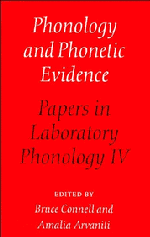Book contents
- Frontmatter
- Contents
- List of contributors
- Acknowledgments
- 1 Introduction
- I Features and Perception
- II Prosody
- 8 Stress shift: do speakers do it or do listeners hear it?
- 9 The phonology and phonetics of the Rhythm Rule
- 10 The importance of phonological transcription in empirical approaches to “stress shift” versus “early accent”: comments on Grabe and Warren, and Vogel, Bunnell, and Hoskins
- 11 Perceptual evidence for the mora in Japanese
- 12 On blending and the mora: comments on Kubozono
- 13 Toward a theory of phonological and phonetic timing: evidence from Bantu
- 14 On phonetic evidence for the phonological mora: comments on Hubbard
- III Articulatory Organization
- Subject index
- Index of names
- Index of languages
13 - Toward a theory of phonological and phonetic timing: evidence from Bantu
Published online by Cambridge University Press: 03 May 2011
- Frontmatter
- Contents
- List of contributors
- Acknowledgments
- 1 Introduction
- I Features and Perception
- II Prosody
- 8 Stress shift: do speakers do it or do listeners hear it?
- 9 The phonology and phonetics of the Rhythm Rule
- 10 The importance of phonological transcription in empirical approaches to “stress shift” versus “early accent”: comments on Grabe and Warren, and Vogel, Bunnell, and Hoskins
- 11 Perceptual evidence for the mora in Japanese
- 12 On blending and the mora: comments on Kubozono
- 13 Toward a theory of phonological and phonetic timing: evidence from Bantu
- 14 On phonetic evidence for the phonological mora: comments on Hubbard
- III Articulatory Organization
- Subject index
- Index of names
- Index of languages
Summary
Introduction
Duration is at the same time one of the easiest and one of the most difficult aspects of speech to analyze: while it is relatively simple to measure duration (as compared to pitch or formant structure, for instance), sorting out what part of duration is linguistically determined – rather than mechanically driven, or put to affective use - is a much more complicated matter (Lehiste, 1970). But much has been said about linguistic timing in the phonological literature, with respect to quantity of vowels and consonants, compensatory lengthening, and the like, so it is appropriate to try to examine phonetic timing in the light of these phonological claims. The goal of this paper is to explore the relation between phonological structure and phonetic output, and the mapping between the two, focusing on the mora as a unit of timing in non-stress languages.
The mora
The importance of phonological timing came to the fore with the development of the autosegmental CV or X tier, which assigns one timing unit to each segment and represents the fact that either the segmental melody or the timing tier may be separately affected by phonological rules (Clements and Keyser, 1983; Levin, 1985). The evolution of this notion into mora or weight-tier theory reflects the insight that phonological timing revolves around weight-bearing elements – syllable nuclei, and sometimes consonants in the rhyme, but never onset consonants; thus on the timing tier, timing units are assigned only to weight-bearers, not to every segment (Hyman, 1984, 1985; Hayes, 1989).
- Type
- Chapter
- Information
- Phonology and Phonetic EvidencePapers in Laboratory Phonology IV, pp. 168 - 187Publisher: Cambridge University PressPrint publication year: 1995
- 8
- Cited by



